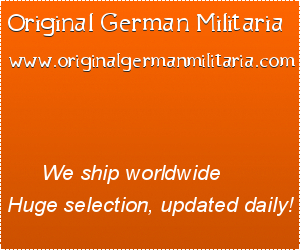Kriegsmarine Belted Coastal Artillery Trousers
SKU: 21.GOR.02.03.04.003
Estimated market value:

Estimated market value:
Attributes
History
The headgear, uniforms, and insignia worn by members of the Kriegsmarine were based upon the designs utilized by the Kaiserliche Marine and the Reichsmarine. The official regulations governing the uniforms of the Reichsmarine were issued on April 5, 1921, and they were embraced, with a few alterations, as the Kriegsmarine uniforms in 1935.
From 1933-1945, the uniforms worn by personnel in the German Navy were produced and disseminated by the Navy Clothing Depot and private manufacturers. The cloth was of a high quality prior the Second World War, but during the war, it became increasingly synthetic. Similarly, the cloth used in the uniforms of Officers and Admirals was of a higher quality than the cloth used in the uniforms of lower ranking personnel, such as Non-Commissioned Officers. The cloth utilized in garments of the blue uniform is of an overall better quality that the cloth utilized in the field-grey uniform. For the field-grey uniform specifically, the cloth is more grey-coloured in pre-Second World War uniforms, while the cloth is more green/olive-coloured in Second World War uniforms.
The buttons worn on Kriegsmarine trousers are generally composed of metal or plastic.
The garments may have proof stamps, serial and unit stamps, and manufacturer marks denoting the legitimacy and origin of the item. They also tend to feature sewn name tabs (namensläppchen) on all clothing items associated with the blue and field-grey uniforms. The blue uniform garments all have a serial number stamp (stammrollennummernstempel), while the field-grey uniform garments have a unit stamp.
The proof stamp is present on all garments produced by the Navy Clothing Depot, and it includes the size of the item, if needed, with the year of manufacture above the size, and a surmounting script that reads “B.A.K.” or “B.A.W.” This stamp information is framed, and written in white ink on blue or black garments and in black ink on all other colour garments.
The serial stamp is composed of letters and numbers, and it is present on blue uniform garments from the Depot. The stamp is either printed in red ink or sewn in red thread. The numbers are preceded by a letter that denotes the area in which the wearer served, with an “N” for Navy Station or an “O” for Navy Station Baltic. The stamp ends in a letter associated with the wearer’s career group, with an “S” for deck personnel and a “T” for technical professionals. Below the serial number is the year in which the wearer entered the navy, surmounted by a horizontal line.
The unit stamp is present on field-grey uniforms. It includes the framed, shortened unit name of the wearer in red ink.
The marks of private manufacturers vary widely, ranging from codes to full names, and even abbreviated letters, as well as the year of manufacture. After 1942, Reich numbers (Reichsbetriebsnummer) were also used as manufacturer marks (RB-).
The M-1943 belted trousers were worn by Officers, all Officer Candidates, and Senior Non-Commissioned Officers as part of the Kriegsmarine field-grey uniform for land forces. These trousers were meant to be worn by in warm or tropical regions, and when it was not necessary to wear the field blouse.
These trousers are composed of several main elements, including the wide waistband, the lining, the buttons, the pockets, and the adjusting strap.
The main attributes which differentiate belted trousers from long trousers is the addition of a wide waistband and the fit of the trouser legs. The waistband is approximately 40-50mm wide, features 4-5 cloth belt-loops for use with a leather belt, and it also has an internal web-belt with a two-pronged black metal belt buckle. The legs of the belted trousers are tapered from the knee down with a slash at the bottom of each leg held together by 2 grey-coloured straps, while the legs of long trousers are straight and not tapered.
The lining of the belted trousers is composed of light-coloured sateen and linen fabric.
These belted trousers were multi-functional and could be worn with suspenders instead of a belt when the field blouse was required for wear. There are two black buttons for suspender attachment located on either side of the rear/seat seam.
The pockets of the belted trousers mirror the style, location, and number of pockets on the long trousers. There are two side “slash” pockets, one on each front panel, as well as a rear pocket on the back right panel with a single button; the back left panel may also feature a non-regulation buttoned pocket. The front and back pockets are made with lining fabric. Additionally, the front left panel of the trousers features a small watch pocket, which was used to hold first-aid field dressing on the long trousers.
The adjustable strap is featured on the rear of the waistline, and it has buttons for sizing.
The M-1943 belted trousers are also known as M-1943 Rundbundhose.


Comments
Sign in to comment and reply.


Scroll Top